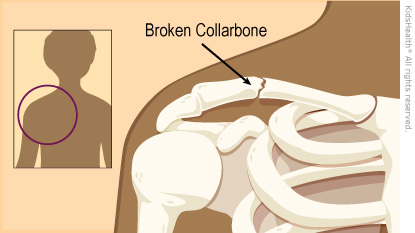Broken Collarbone (Clavicle Fracture)
What Is a Broken Collarbone?
The collarbone (also called the clavicle) is the bone that connects the breastbone to the shoulder. A broken collarbone, also called a clavicle fracture, is when this bone breaks.
How Does a Broken Collarbone Happen?
Falling hard on a shoulder or an outstretched arm can fracture a collarbone. This can happen in sports like football, lacrosse, hockey, biking, skateboarding, and skiing. It can also happen when a young child falls from playground equipment or out of a bed or crib. The collarbone also can break in a car crash or if someone is hit by a car.

What Are the Signs & Symptoms of a Broken Collarbone?
Someone who breaks a collarbone might have:
- pain over the collarbone
- trouble moving the arm or shoulder on that side
- swelling, tenderness, and bruising along the collarbone
- a bulge or “tenting” of the skin above the break
How Is a Broken Collarbone Diagnosed?
To diagnose a collarbone fracture, health care providers:
- ask about the injury
- do a physical exam
- order X-rays
How Is a Broken Collarbone Treated?
Most broken collarbones heal with ice, arm support, pain medicine, and exercises. The arm is supported either by a sling or a shoulder immobilizer. A shoulder immobilizer is like a sling, but also has a strap that goes around the waist.
To care for your child while the collarbone heals:
- Use ice for pain and swelling. Put an icepack, cold gel pack, or bag of frozen vegetables over the collarbone for 20–30 minutes every 2–3 hours. Be sure to put a towel between the ice/cold pack and your child’s skin.
- Use the sling or shoulder immobilizer as directed by your health care provider. Your child will wear it for about a month, but can remove it during bathing and sleeping.
- Follow your health care provider’s instructions on giving medicine for pain.
For about the first 4–6 weeks, your child should:
- Avoid raising the arms higher than shoulder level.
- Not lift anything that weighs more than 5 pounds (2.3 kg). This is about the weight of a 72-ounce bottle of liquid laundry detergent.
- Stay out of all sports and physical education.
- Do all exercises to prevent elbow and shoulder stiffness and to help with muscle strength.
- Go to physical therapy, if needed.
- Go to all follow-up doctor visits.
Call your health care provider if your child has pain or swelling that gets worse.
Will the Collarbone Heal Straight?
Even if the broken bones aren’t perfectly lined up, the body usually can make them straight again. That’s because the collarbone has a thick periosteum (outer layer of the bone). The collarbone periosteum doesn’t usually break, so it acts like a sleeve to hold the bone together while it heals. Rarely, the doctor might recommend surgery if the broken bones are very out of line.
Sometimes, there’s a bump where the bone broke. In kids who are still growing, the bump tends to get smaller and go away within a year. Sometimes the bump doesn’t fully go away. But it doesn’t hurt or cause other problems with the arm or shoulder.
When Can My Child Go Back to Sports?
Your health care provider will see your child again and let you know when it’s OK to go back to sports. This is usually when:
- There’s no pain when the health care provider presses on the collarbone.
- Shoulder strength is normal.
- Your child can move and use the arm and shoulder without pain.
In general, kids can go back to noncontact sports (such as running or swimming) in about 6 weeks and contact sports (such as football, lacrosse, and hockey) in 8–12 weeks.
Looking Ahead
Most broken collarbones heal quickly and completely. Within a few months, your child should be able to do everything he or she did before the injury.
